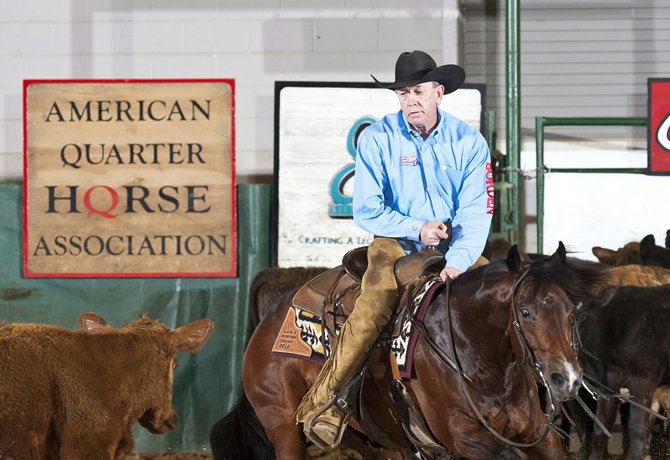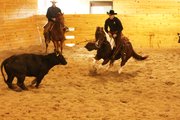A good cutting horse gets down to a cow’s eye level to keep it from the herd. Photo by Forrest Photography/Courtesy National Cutting Horse Association
Watching a highly trained cutting horse with "cow sense" is an athletic event on par with few equine sports. This event traces its lineage back to the Old West on ranches--cowboy days. When a cow needed to be singled out of the herd for a particular reason such as needing medical attention, cowboys would use their horses to "cut" the cow.
Ty Hillman, manager of industry relations for the National Cutting Horse Association, explained the sport this way: "Horse cutting is when a rider rides into a herd of cows to cut two to three cows to showcase the horse's ability."
After the rider picks out a cow to cut, the horse tries to keep the cow from returning to the herd. "The judges look to see if the rider takes his hands off the reins and on to the horse's neck," Hillman says. "This is so the judges can see the horse is keeping the cow from the herd on its own by using its training, and is not directed by the rider."
I could sort of picture what Hillman was explaining but he went a step farther to explain the sport to me (someone who has never seen it) using an analogy I could understand. "Think of the cow as a running back in football," Hillman describes. "Now imagine the horse and rider as the defense and the herd as the end zone."
"The cow (running back) wants to get back to the herd (the end zone), and the horse and rider want to keep the cow from the herd to showcase the horse's ability," Hillman says. "The horse keeps working until the rider allows the cow to rejoin the herd or the cow is able to get past the horse and rejoin the herd on its own."
Hillman added that cows have a strong herd mentality, and an isolated cow desperately wants to rejoin its herd.
It's up to the horse to anticipate the moves and block the cow from the safety of the herd, and up to the rider to hang on and not unbalance the horse.
"It is easy to fall off the horse if the rider is looking right and thinking the cow is going right," Hillman says. "The horse might go left because the cow goes left."
Riders--who can be as young as 10 and as old as 60 or 70--can allow the cow to rejoin the herd when the cow stops moving its feet or turns away from the rider. The horse knows to let the cow go when the rider picks up the reins.
The primary breed for cutting horses are American Quarter Horses, but other breeds, such as American Paint Horses, might be used as well. Cutting horses are built lower to the ground so that they can move laterally quickly. They're bred for cow sense and trained to become experts at their event.
Hillman says the horse will nearly drag its belly on the ground to get low enough--at eye level with a cow--and to move back and forth to block the cow from rejoining the herd. Each rider has two and a half minutes to impress from one to as many as five judges depending on how many entries are in each event. With five judges, the lowest and highest scores are thrown out.
Cutting is open to novice, amateur, youth and professional riders. Classes are based on rider or horse, and Hillman says there is a class that everyone can enter. Most new participants start by entering a $2,000 Rider Class. That means the rider has not won more than $2,000 in prize money at a cutting horse event. Professional trainers generally enter open events.
The Eastern National Championships for cutting horses started March 4 in Jackson and will run through March 16 at the Kirk Fordice Equine Center. Four Sixes Ranch, or 6666 Ranch, sponsors the show. A western lifestyle trade show accompanies the event. Admission is free for the viewing public. There are 12 standard classes to watch, and Hillman says even watching novices is fun for people watching cutting horses for the first time. A total of $500,000 in cash and prizes will be awarded during the event, with the money events in the finals of each class.
Events start each day at 8 a.m. at the Mississippi State Fairgrounds (1207 Mississippi St.). Follow the events on Facebook by liking the National Cutting Horse Association or on Twitter by following the NCHA at @nchalive. Find out more about cutting horses at nchacutting.com.



